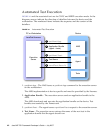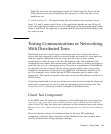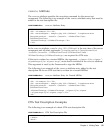
48 Java ME TCK Framework Developer’s Guide • July 2007
5. Check or Send Message- The test sends either a message or a check message
request to the Framework messaging service on the harness.
6. Get Message - The Framework messaging service on the harness sends the test a
get message command.
7. Check or Send Message - The server-side test sends either a message or a check
message request to the Framework messaging service on the harness.
8. Get Message - The Framework messaging service on the harness sends the
server-side test a get message command.
9. sendTestResult - The agent returns the test result to the execution server.
The agent repeats items 3, 4, and 9 until all tests in the application bundle are run.
When all tests in the application bundle are run, the AMS requests the next
application bundle (items 1 and 2) and the sequence is repeated until all tests and all
test bundles in the test suite are run.
Testing User Interfaces With Interactive
Tests
Interactive tests are the tests that require some form of user interaction and cannot
be executed without such interaction. From a design point of view, interactive tests
are a subtype of distributed test. As a subtype of distribute test, interactive tests
generally execute on the test device under the control of a component called an
agent. However, unlike distributed tests, interactive tests also require some form of
user interaction as a part of the test. Interactive tests might require that the user
change something with a device, which triggers event generation or require the user
to verify that a device plays sound or vibrates. But most typically, interactive tests
are used to validate user interface on the device.
The Framework supports the following three types of interactive modes:
■ Yes-No - The user must determine the outcome of the test.
■ Done - The user must perform specific actions and confirm the completion, but
cannot affect the outcome of the test.
■ Information-only - The visual component is presented to the users, but no user
action is required (this is the default mode).
To develop interactive tests, the test writer must write classes for both the client and
the remote test components of the interactive test as well as create an appropriate
test description file. The AdvancedTestSuite directory contains examples of
interactive tests.


















